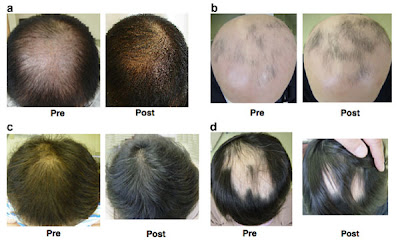This is the third post in a series about the effect of soy on hair growth. So far, we've seen that soy protein reduces DHT in men, and that soy isoflavones reduce DHT but increase testosterone in mice. While this seems like a good thing from a hair loss perspective, it doesn't guarantee that eating soy will actually prevent balding. So, time for some more studies.
The paper we'll look at today suggests that a combination of isoflavones and capsaicin grows hair in mice and in humans (link). The mice received capsaicin via injection and isoflavones through their diet, while the human participants took both orally as supplements.
Study method
For the mouse study, the mice were divided into three groups: one received capsaicin only, the second received capsaicin and isoflavones, and the third was a control group. Though the full paper doesn't explicitly state soy isoflavones anywhere and just talks about isoflavones in general, the "Fujiflavone P40" product they used in the diet is extracted from soy beans, so we can assume that the results apply to soy isoflavones.
The human study included 48 volunteers, 25 men and 23 women. 34 suffered from androgenetic alopecia (AGA), 13 from alopecia totalis (AT), and one from alopecia areata (AA). The participants were randomly divided into two groups: the first one received 6 mg capsaicin and 75 mg isoflavone daily, and the second received placebo only.
Capsaicin and IGF-1
Insulin-like growth-factor 1 (IGF-1) is involved in promoting hair growth in humans and animals. Indeed, mice that have been genetically modified to overexpress IGF-1 develop hair follicles earlier than controls, and humans with an IGF-1 deficiency have sparse hair growth. One explanation is that IGF-1 produced by dermal papilla cells might promote hair growth through stimulation of keratinocyte proliferation in hair follicles.
When the mice in this study were administered capsaicin, their dermal levels of insulin-like growth-factor 1 (IGF-1) increased significantly. On the other hand, CGRP-knockout mice did not show increased IGF-1. The authors suggest that increased CGRP, or calcitonin-gene related peptide, production leads to increased IGF-1, which in turn leads to hair growth.
In mice, the combination of capsaicin and isoflavone increased IGF-1 more than capsaicin alone. This makes sense, since isoflavone increases CGRP production. In humans, IGF-1 levels were increased after 5 months in the participants taking capsaicin and isoflavone orally, while they were not increased in those receiving placebo.
Capsaicin, isoflavone and hair growth
After four weeks of treatment, the rats receiving either capsaicin or capsaicin and isoflavone had grown more hair then the control rats. Consistent with the observed increases in IGF-1, the combination of isoflavone and capsaicin was more effective than capsaicin alone.

The leftmost image above shows three of the control rats after 4 weeks. The center image is of the capsaicin group, and the rightmost image is of the capsaicin + isoflavone group.
After 5 months, hair growth was significantly increased in 64.5% of human volunteers administered with capsaicin and isoflavone, compared with 11.8% in the placebo group. Furthermore, 88% of the participants suffering from androgenic alopecia saw a promotion of hair growth when given capsaicin and isoflavone. This suggests that the treatment might be more effective for male-pattern baldness than other types of hair loss. Below are some samples of the humans treated with oral capsaicin and isoflavones.

The upper left picture (a) is of a 54-year-old male with androgenic alopecia. That's a pretty significant result right there. The picture in the upper right corner (b) is of a 29-year-old male with alopecia totalis. Some hair growth is evident, but not a full recovery. The lower left corner (c) is of a 39-year-old female with androgenic alopecia, showing some thickening of the crown area. The lower right corner (d) is of a 40-year-old female with alopecia areata.
Conclusion
A combination of soy isoflavones and capsaicin increases dermal levels of IGF-1 and promotes hair growth in humans and mice. While some in vitro studies have suggested IGF-1 to be deleterious to hair growth, this study shows that the result may be different in vivo.
The amounts used in the study are quite reasonable. Chilli, cayenne pepper and red pepper contain between 0.1 mg to 60 mg capsaicin per gram (link, link, link, link). Given that a tablespoon of ground spice weighs about 8 grams, one tablespoon of ground chili pepper would contain anywhere between 0.8 mg and 480 mg of capsaicin. The hotter the pepper, the more capsaicin it contains.
As for soy, the best source of isoflavones are soy beans, which contain about 200 mg isoflavones per 100 grams (link). Tofu contains ~35 mg per 100 grams, while soy milk contains only ~9 mg. Thus, to get the 75 mg used in the study, you would either need to eat about 40 grams of soy beans (dry weight), a little over 200 grams of tofu, or a little less than a liter of soy milk.
Both capsaicin and soy isoflavones (mainly daidzein and genistein) are also commonly available as supplements.
For more information on soy, cayenne and hair growth, see these posts:
Do Flax Lignans Reduce Hair Loss from MPB?
Soy Protein Isolate Reduces DHT in Healthy Young Men
Green Tea and Capsaicin Reduce Hunger and Calorie Intake
Emu Oil and Hair Growth: A Critical Look at the Evidence







